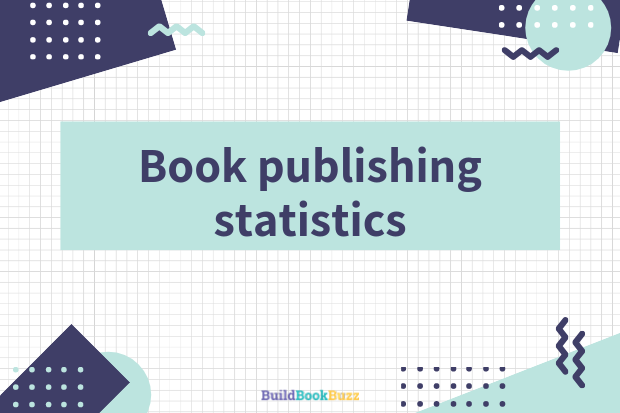Book publishing statistics
Authors who want to succeed in this profession need to stay on top of the book publishing industry.
One way to do that is by monitoring the numbers. Book publishing statistics often indicate trends that can help guide your career.
For example, when authors grumble about Amazon and say they aren’t going to list their books there, I point out that Amazon sells 83 percent of the e-books purchased in the U.S.
Some authors need guidance on pricing. Knowing the average e-book price helps keep you from pricing yourself out of the market.
Others debating whether to create an audiobook version need to know if people are listening to audiobooks.
With that in mind, I’ve compiled this statistics collection to help guide your decision making.
I’ve only included information I can verify, meaning, I haven’t linked to statistics in articles that don’t provide research source attribution. That kind of information isn’t always accurate.
Bookstores
In 2018, sales of books in U.S. bookstores were down from 2010, going from $15.24 billion that year to $10.28 billion in 2018.
There were 1,835 independent bookselling companies running 2,470 independent bookstores in 2018.
In 2017, 24 percent of people purchased the same number of print books in stores as they did online.
Formats: print, e-book, audiobook
In 2017, 879,6000 self-published books were published in a print format and 129,600 were e-books.
As of early February 2019, 72 percent of U.S. adults say they have read a book in any format in the past 12 months . That number is about the same as what it was in 2012.
According to that research, Americans report that they prefer the print book format, with 65 percent of adults saying they had read a print book in the year before the survey.
As of April 2017, 47 percent of U.S. readers purchased up to five print books within the past 12 months.
E-books
 32 percent of U.S. readers purchased up to five e-books as of April 2017.
32 percent of U.S. readers purchased up to five e-books as of April 2017.
Until February 2017, indie authors accounted for 40 percent of U.S. e-book sales.
Almost all libraries offer e-books — 94 percent of them do.
U.S. trade e-book sales revenue in 2018 was $1.02 billion, down slightly from the year before.
About 26 percent of those in the U.S. read e-books.
Almost one-quarter — 24 percent — of sales revenue for e-books on Amazon is from indie books.
Audiobooks
As of early February 2019, 20 percent — one in five Americans — reported listening to at least one audiobook in the past 12 months.
U.S. audiobook sales revenue grew from $900 million in 2009 to $2.5 billion in 2017.
Downloaded audio is the fastest growing format, with 181.8 percent revenue growth from 2014 to 2018.
Who reads books?
Gen Z, Millennials/Gen Y, and Gen X read the most books.
Those ages 18 to 29 as of 2018 read the most — 84 percent of them read a book in any format in the previous 12 months. People ages 30 to 49 in 2018 were the next largest group of readers, at 74 percent.
Publishers
During 2018, publishers’ net revenue (not retailer/consumer sales) increased 1.5 percent to $16.19 billion.
That year, publishers sold more online — $8.03 billion — than they did in physical stores — $6.90 billion.
Also in 2018, publisher sales by format broke down to 45.1 percent print, 24.5 percent e-book, 14.5 percent instructional material, 13.7 percent downloaded audio, and 2.2 percent physical audio or a different format.
Authors
 In 2018 in the U.S., there were 45,200 writers and authors.
In 2018 in the U.S., there were 45,200 writers and authors.
Only 21 percent of the full-time published authors in 2018 earned all of their income from books.
The wealthiest author in the world in 2018 was James Patterson.
About a half-million self-published authors sold 240 million e-books in 2017.
Book pricing
The average price of an e-book in 2017 was $2.99 (scroll down to the slide show; see slide 52).
In traditional publishing, books written by women are listed at nearly half (45 percent) the price of those written by men.
A chart published with the study about gender bias in pricing includes the average maximum price per book category according to genders.
Popular book genres
As of 2015, mystery/thriller/crime was the most popular genre, with 47 percent of survey respondents reporting they had read books in that category that year.
In 2016, romance fiction made up 23 percent of the fiction market. In 2017, readers purchased almost 21.5 million romance books.
Figures from 2017 show that nonfiction self-help books increased the most over the previous year, by 18 percent. Craft and hobby books decreased the most, at 29 percent.
Let this data help you make informed publishing decisions.
Which of these statistics surprised you the most? Please tell us in a comment.
Like what you’re reading? Get it delivered to your inbox every week by subscribing to the free Build Book Buzz newsletter. You’ll also get my free “Top 5 Free Book Promotion Resources” cheat sheet immediately!


Very interesting compilation. Thanks!
Thanks, Vicki! I sort of went down a rabbit hole with this one. I hope it helps with proposals, decisions, etc.
Sandy
I had to laugh about the 500,000 self-published authors selling 240 million books. That averages out to 480 books each. Made me feel better about going the traditional route, even though a couple of my books still have not topped that average.
Great post!
And, Randi, the average traditionally published author sells about 150-250 books in a lifetime (according to a Library of Congress talk I went to).
Interesting, right? This can be both a benchmark and a reality check for authors.
Sandy
The publishing model you choose depends on a number of factors. I’m sure you’ve thought through your options and know that traditional publishing was a wise choice for you!
Sandy
According to Price’s law, 10% of the authors will sell 50% of the copies;
so 50,000 authors sell 120M books. Of that 10%, 10% will sell 50% of those copies; so 5,000 authors sell 60M books. Conversely the 2nd 10% sell 50% of the 120M books, or 5,000 60M books; so the top 20% of authors sell 180M books combined; or 2/3s of all books being sold by 10,000 authors. The 3rd decile sells 50% of 60M books or 30M; so the top third of authors sold 210M books. The goal is not to be in the bottom 70% who only sold 30M books.
This leads to the famous long tail. This is true in most domains, and is why the top couple of percent in a domain tend to earn disproportionately more than the remainder.
You wrote 60 non-fiction books in a niche market over the past 14 years, or about 4 books per year. Non-fiction sells fewer copies per title generally. Your success owes as much to your post-secondary degrees in English and 34 years in writing copy professionally than your having a traditional publisher.
If you look at movements like 20Booksto50K, you see that a decent self-published author who publishes roughly 4 books per year can be self-sustaining after a few years due to brand effects. This assumes the author was mindful of the need for a professional product and marketing (which is your background).
So, you may likely have done as well going self-published as you did traditionally.
Bishop, regarding your 20Booksto50K observation, it’s likely that those authors are writing fiction, and particularly series fiction. Yes? (Randi writes nonfiction.)
Sandy
I’m a latecomer to Audio … but since I started listening to books on audio, I’ve read so many more books. But because I get my free credits each month, I like spending them on higher priced books. I wouldn’t use a credit to download a book priced under $10 – so I think authors have a potential of pricing their audio books at a premium price to attract readers on a Audible subscription.
I loooove audiobooks! The Libby app from the library has made it possible for me to find and get hooked on many new-to-me authors, too. That’s an interesting pricing observation, too. Thanks!
Sandy
Thanks a gadzillion Sandy. I was beginning to research this info as a necessary ingredient for a kickstarter campaign. Then, voila! Magically you had already done this for me.
Molli, I’m THRILLED that this came to you at the right time. Thanks for letting me know!
Sandy
“books written by women are listed at nearly half the price” of those by men! That statistic startled me. Thank you for compiling this, Sandra!
That one surprised me, too, Anne!
Sandy
Very interesting Sandra. Many thanks for sharing!
Some of these don’t make sense to me.. only 45 thousand authors in the US in 2018? That’s definitely not true. It can’t be that low. Esp., since the next stat says half a million authors sold 240 million books in 2017. Maybe there is a 0 missing in the first stat?
And amazing to see books sold over 10 Billion dollars worth! Wow.
Adrijus, the text at the link corresponding to the statistic refers to “professional U.S. writers.” That’s staff writers or those who make a living as freelance writers, etc. Some of them are probably self-published authors, but self-pubbed authors who aren’t on payroll as writers, don’t earn a FT living from their royalties, or earn their living through other professions and write books on the side won’t be included in that number.
Sandy
Excellent. Thanks for posting.
You’re welcome, Larry!
Sandy